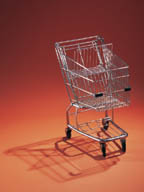
As Obesity Spreads, Dieters Diversify
JUNE 2004--According to the International Obesity Task Force, part of the International Association for the Study of Obesity (London), about one in every four people on Earth is too fat, while about two of every three Americans fall into that category. Around the globe, some 1.7 billion people should lose weight, says the report, and roughly 312 million are obese—at least 30 pounds over their highest recommended weight.The task force believes a third of all deaths around the world spring from ailments related to weight, lack of exercise and smoking; however, the “most worrisome trend” is the spread of obesity beyond wealthy Western countries. In response, the World Health Organization (Geneva) is expected to propose the first global strategy on diet, physical activity and health.
A study by the NPD Group (Port Washington, N.Y.) finds a number of Americans already attempting to fight the obesity battle. The group's Dieting Monitor, however, reveals that these efforts are not cookie-cutter examples; rather, the most popular diet plan is described as “My Own Diet,” an adjusted version of a number of diets that fits their lifestyles. Some 25% have formulated their own diet, and nearly 7% are currently following it.
Interestingly, about 17% of Americans have tried the Atkins diet, though only about 4% are currently on a low-carb plan. Instead, Americans appear to be cutting their carbohydrate intake in a pick-and-choose manner, trying low-carb, high-protein offerings but not necessarily strictly adhering to the diet.
The dieting efforts have led to some weight reductions, but most dieters say they have a long way to go. Around 24% of dieting adults have lost less than five pounds, while 22% have dropped five to 10 pounds and 19% are 11 to 20 pounds lighter. Almost half (46%) say they still need to lose another 21-30 pounds.
Making a List
According to the Customer Focus 2004: Grocery Study released by Vertis (Baltimore), 71% of female chief grocery shoppers (i.e., those responsible for 60% or more of household grocery shopping) who read advertising inserts make lists and plan their grocery shopping efforts based on items viewed in advertising inserts or circulars.Therese Mulvey, vice president of marketing research at Vertis, notes, “Grocery marketers who want to have an impact with female chief grocery shoppers should consider the significant role this medium has in determining which items are purchased and where they purchase them.”
Advertising inserts and circulars most influence the buying decisions of 28% of all adults, 6% more than the total number who regard television as their primary influence.
Asked about their shopping patterns, 21% of all adult shoppers said they had bought perishable products at a super discount store (i.e., Wal-Mart Super Center, Meijer, Super Target) within the prior two weeks. Some 13% said they had purchased the same items at wholesale or warehouse club stores (such as Sam's Club or Costco). Warehouse stores accounted for 10% of non-perishable purchases, which were purchased in super discount stores by 19% of respondents. About 25% of shoppers who purchased non-perishable items at an outlet other than a grocery store spent in excess of $101.
For more information on the Customer Focus 2004: Grocery study, contact Michelle Metter or Donovan Roche, 619-234-0345.
The In Box:


